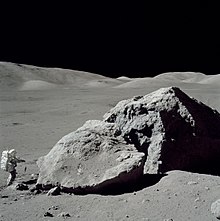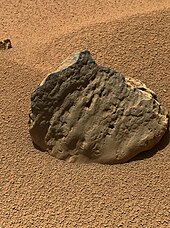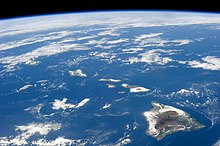NASA research


Since its establishment in 1958, NASA has conducted research on a range of topics. Because of its unique structure, work happens at various field centers and different research areas are concentrated in those centers.[1] Depending on the technology, hardware and expertise needed, research may be conducted across a range of centers.[2]
Aeronautics
The Aeronautics Research Mission Directorate (ARMD) is one of five mission directorates within NASA, the other four being the Exploration Systems Development Mission Directorate, the Space Operations Mission Directorate, the Science Mission Directorate, and the Space Technology Mission Directorate.[3] The ARMD is responsible for NASA's aeronautical research, which benefits the commercial, military, and general aviation sectors. The current NASA associate administrator heading ARMD is Robert A. Pearce who has held the position since 2019.[4]
ARMD is involved in the creation of the Next Generation Air Transportation System (NextGen).[5]
A 2014 audit by the NASA Office of Inspector General reported that ARMD "solicits input from industry, academia, and other Federal agencies regarding research needs and...uses this information to develop its research plans", and concluded that the directorate supported "advancement of the nation's civil aeronautics research and technology objectives consistent with the National Plan" established in 2006.[6]
ARMD performs its aeronautics research at four NASA facilities: Ames Research Center and Armstrong Flight Research Center in California, Glenn Research Center in Ohio, and Langley Research Center in Virginia.[5]Medicine in space
A variety of large-scale medical studies are being conducted in space by the
Salt evaporation and energy management
In one of the nation's largest restoration projects, NASA technology helps state and federal government reclaim 15,100 acres (61 km2) of salt evaporation ponds in South San Francisco Bay. Satellite sensors are used by scientists to study the effect of salt evaporation on local ecology.[10]
NASA has started Energy Efficiency and Water Conservation Program as an agency-wide program directed to prevent pollution and reduce energy and water utilization. It helps to ensure that NASA meets its federal stewardship responsibilities for the environment.[11]
Earth science
Main page: NASA Earth Science

Understanding of natural and human-induced changes on the global environment (such as
NASA is working in cooperation with
On May 8, 2003, Environmental Protection Agency recognized NASA as the first federal agency to directly use landfill gas to produce energy at one of its facilities—the Goddard Space Flight Center, Greenbelt, Maryland.[18]
Ozone depletion
In 1975, NASA was directed by legislation to research and monitor the upper atmosphere. This led to Upper Atmosphere Research Program and later the Earth Observing System (EOS) satellites in the 1990s to monitor ozone depletion.[19] The first comprehensive worldwide measurements were obtained in 1978 with the Nimbus 7 satellite and NASA scientists at the Goddard Institute for Space Studies.[20]
Climate study
Within the Earth science program, NASA researches and publishes on
References
- ^ "3". www.hq.nasa.gov. Archived from the original on 2021-01-27. Retrieved 2018-07-26.
- ^ "NASA Strategic Management Handbook". www.hq.nasa.gov. Archived from the original on 2021-05-10. Retrieved 2018-07-26.
- ^ Foust, Jeff (September 22, 2021). "NASA splits human spaceflight directorate into two organizations". Space News. Retrieved September 11, 2022.
- ^ "NASA Administrator Names Robert Pearce Head of Agency Aeronautics". NASA. December 10, 2019. Retrieved September 6, 2022 – via prnewswire.
- ^ a b "About Us". Nasa.gov. NASA. Archived from the original on 12 May 2013. Retrieved 17 June 2016.
- ^ NASA Office of Inspector General (January 30, 2014). "NASA OIG: The Aeronautics Research Mission Directorate's Management Strategy for Conducting Aeronautics Research". Spaceref.com. Retrieved 23 June 2016.[permanent dead link]
- ^ "NASA—Advanced Diagnostic Ultrasound in Microgravity (ADUM)". NASA. July 31, 2010. Archived from the original on August 23, 2007. Retrieved August 13, 2010.
- S2CID 30566494.
- PMID 15533948.
- ^ "NASA Helps Reclaim 15,100 Acres Of San Francisco Bay Salt Ponds". Space Daily. 2003. Archived from the original on 2011-05-23. Retrieved May 1, 2008.
- ^ Tina Norwood (2007). "Energy Efficiency and Water Conservation". NASA. Archived from the original on January 17, 2008. Retrieved May 1, 2008.
- ^ "Taking a global perspective on Earth's climate". Global Climate Change: NASA's Eyes on the Earth. Archived from the original on July 24, 2011.
- ^ Eric Berger, "Houston Chronicle," April 29, 2015 "A history primer: NASA's robust Earth Science program now under attack originated in the Reagan and Bush administrations," http://blog.chron.com/sciguy/2015/04/a-history-primer-nasas-robust-earth-science-program-now-under-attack-originated-in-the-reagan-and-bush-administrations/
- Berger, Eric (2015-10-29). "Republicans outraged over NASA earth science programs... that Reagan began". Ars Technica. Retrieved 2023-07-12.
- ^ D. Renné; S. Wilcox; B. Marion; R. George; et al. (2003). "Progress on Updating the 1961–1990 National Solar Radiation Database" (PDF). NREL. Retrieved May 1, 2008.
- ^ EPA (1999). "EPA, DOE, NASA AND USAF Evaluate Innovative Technologies". EPA. Retrieved April 28, 2008.
- ^ Benjamin S. Griffin; Gregory S. Martin; Keith W. Lippert; J. D. MacCarthy; et al. (2007). "Joint Group on Pollution Prevention" (PDF). NASA. Archived from the original (PDF) on May 27, 2008. Retrieved May 1, 2008.
- ^ Michael K. Ewert (2006). "Johnson Space Center's Role in a Sustainable Future" (PDF). NASA. Archived from the original (PDF) on May 27, 2008. Retrieved April 28, 2008.
- ^ W. Henry Lambright (May 2005). "NASA and the Environment: The Case of Ozone Depletion" (PDF). NASA. Retrieved June 28, 2012.
- ^ Dr. Richard McPeters (2008). "Ozone Hole Monitoring". NASA. Archived from the original on May 9, 2008. Retrieved May 1, 2008.
- ^ NASA's climate page. climate.nasa.gov/
- ^ Hille, Karl (2016-07-19). "2016 Climate Trends Continue to Break Records". NASA. Retrieved 2023-07-12.
- ^ "Trump adviser proposes dismantling NASA climate research". The Washington Post. Retrieved 2023-07-12.
- ^ "Scientists are frantically copying U.S. climate data, fearing it might vanish under Trump". The Washington Post. Retrieved 2023-07-12.
